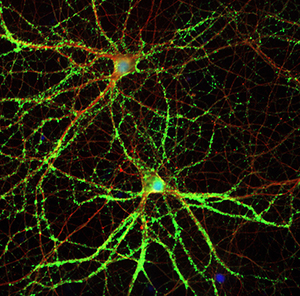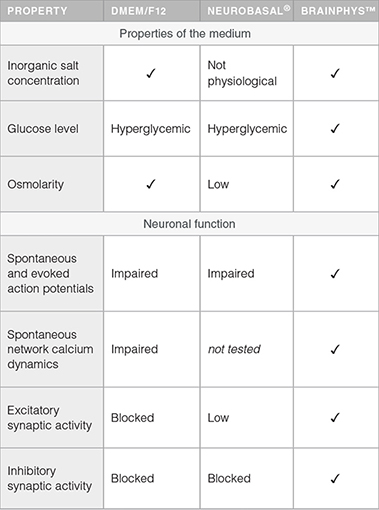
BrainPhys™ – A New Way to Culture Neurons
Abnormal or diminished neuronal function is one of the hallmarks of many neurological disorders, including schizophrenia, Parkinson’s disease, Alzheimer’s disease, Huntington’s disease, autism spectrum disorders and amyotrophic lateral sclerosis (ALS).1 For researchers who model these diseases in vitro, it’s essential to use a culture system that supports neuronal functions, including spontaneous electrical activity and evoked action potential firing. Now, with the invention of BrainPhys™,2 researchers can choose a neuronal basal medium designed to promote optimal culture conditions for primary rodent or human pluripotent stem cell (hPSC)-derived neurons.
The traditional cell culture techniques that are commonly used now were developed in the 1970s and 1980s when the main goal was simply to maintain cells in vitro,3 long before we had the ability to generate multiple kinds of neuronal cell types from hPSCs. For neuron-specific media, little has changed since Neurobasal medium was developed over 20 years ago.4 Historically, neuroscience researchers have primarily used rodent neuronal cultures to model central nervous system (CNS) development and disease. Mouse or rat neurons are typically maintained for 2-3 weeks, but modern hPSC-derived neurons may need to be cultured for months, reflecting the longer time-course of human nervous system development.5 The question of how neuronal activity is affected when neurons are cultured long-term has mostly been ignored; this is now considered a technical problem for the field.3 One of the limitations of traditional neuronal culture media are illustrated by the need to switch to artificial cerebrospinal fluid (aCSF) for functional assays, such as patch clamping. Because traditional culture media inhibit activity and aCSF is not suitable for long-term culture, neurons do not develop in vitro under normal functional conditions. This could diminish the relevance of this culture system for modeling the CNS.
Realizing the shortcomings of traditional culture media, Dr. Cedric Bardy (in the laboratory of Dr. Fred H. Gage) set out to identify which components should be altered to better support in vitro neuronal activity. Dr. Bardy demonstrated that many crucial neurophysiological properties, such as action potential generation and synaptic activity, are impaired or nonexistent when neurons are cultured in traditional culture media used for primary neurons (Neurobasal) or hPSC-derived neurons (DMEM/F12) (Table 1). After adjusting salt and glucose concentrations and fine-tuning osmolarity and pH levels, BrainPhys™ was born, published in C Bardy et al. Proc Natl Acad Sci USA, 2015. STEMCELL Technologies Inc. has developed BrainPhys™ Neuronal Medium based on this formulation.
Table 1. Properties of Culture Media2

When we compared neurons cultured in BrainPhys™ Neuronal Medium to those cultured in traditional culture media (under the same supplementation conditions), our findings were consistent with Bardy et al. Morphology and marker expression are consistent with traditional neuronal media (see data) but the frequency and amplitude of spontaneous excitatory (AMPA receptor-mediated) and inhibitory (GABA receptor-mediated) synaptic currents are increased in BrainPhys™ Neuronal Medium-matured cultures (Figure 1). In a recent webinar, Dr. Bardy commented on the importance of using a culture medium that can support fundamental neuronal functional in vitro:
“We believe it’s important not only to generate neurons that can fire action potentials, but to have them firing and communicating through synapses while they’re in the incubator; not just when you test them for electrophysiology with aCSF.”

The traditional culture media used by researchers impair neuronal activities and other fundamental neuronal functions. As our knowledge of the brain and the central nervous system expands and our use of human neurons for research increases, it’s crucial to find a complementary culture system. With the invention of BrainPhys™, the neuronal culture system is now much closer to the brain’s environment, reducing the gap from the brain to the bench.
Go to www.BrainPhys.com to learn more and get a free sample of BrainPhys™ Neuronal Medium.
Footnotes
-
1. Ichida JK and Kiskinis E (2015) Probing disorders of the nervous system using reprogramming approaches. EMBO J 3;34(11):1456-77.
-
2. C Bardy et al. (2015) Neuronal Medium that supports basic synaptic functions and activity of human neurons in vitro. Proc Natl Acad Sci 112 (20) E2725-E2734.
-
3. FJ Livesey (2015) Reconstructing the neuronal milieu intérieur. Proc Natl Acad Sci 112 (20):6250-1.
-
4. Brewer GJ et al. (1993) Optimized survival of hippocampal neurons in B27-supplemented Neurobasal, a new serum-free medium combination. J Neurosci Res. 35(5):567-76.
-
5. Sandoe J, Eggan K (2013) Opportunities and challenges of pluripotent stem neurodegenerative disease models. Nat Neurosci 16(7):780-789.